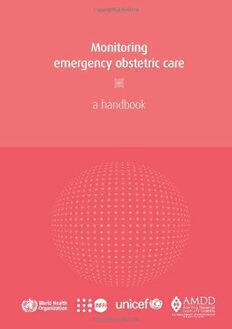
Monitoring Emergency Obstetric Care: A Handbook (2009) PDF
164 Pages·2009·1.82 MB·English
Most books are stored in the elastic cloud where traffic is expensive. For this reason, we have a limit on daily download.
Preview Monitoring Emergency Obstetric Care: A Handbook (2009)
Description:
This handbook is an update of an earlier publication on monitoring the availability and use of obstetric services issued by UNICEF WHO and UNFPA in 1997. The indicators defined within the publication have been used by ministries of health, international agencies and program managers in over 50 countries around the world. This revision incorporates changes based on monitoring and assessment conducted worldwide and the emerging evidence on the topic over the years and has been agreed by an international panel of experts. It includes two new indicators and an additional signal function with updated evidence and new resources. This handbook describes the indicators and gives guidance on conducting studies for people working in the field. It includes a list of life-saving services or signal functions, that define a health facility with regard to its capacity to treat obstetric emergencies. The emphasis is on actual, rather than theoretical functioning. The emergency obstetric care indicators described in this handbook can be used to measure progress in a programmatic continuum: from the availability of and access to emergency obstetric care to the use and quality of those services.
See more
The list of books you might like
Most books are stored in the elastic cloud where traffic is expensive. For this reason, we have a limit on daily download.
